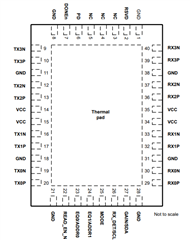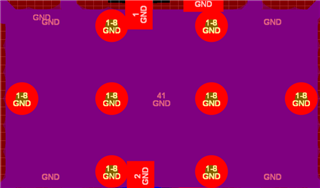Other Parts Discussed in Thread: DS320PR410
Tool/software:
Why do we need to consider thermal vias and solder paste for redrivers at the board layout stage, and how should they be handled?
This thread has been locked.
If you have a related question, please click the "Ask a related question" button in the top right corner. The newly created question will be automatically linked to this question.
Tool/software:
Why do we need to consider thermal vias and solder paste for redrivers at the board layout stage, and how should they be handled?
Introduction:
Redrivers with QFN packages have pins laid out on the bottom edges of the package, and most of the bottom area of the package is occupied by a "thermal pad", sometimes also known as a "DAP" or "EP". A common feature for integrated circuits, the thermal pad is connected to the device GND and is illustrated (not necessarily to scale) in the pinout diagrams for the datasheet.

Like the name suggests, one of the main roles of the thermal pad is to dissipate heat from the device to the board. The ground plane of the board typically has a lot of copper and can function adequately as a heat reservoir to help keep the redriver cool. Unlike retimers, redrivers have low enough heat generation that they typically do not require dedicated external heat sinks.
Connecting the thermal pad to GND should be done by adding multiple vias that link the pad to the internal GND layers of the board. We typically refer to these as "thermal vias".

On a high-speed signal conditioning device, the thermal vias are also important for another reason besides temperature: they help ensure that the device has strong, low-impedance GND connections across its circuitry that are less vulnerable to ground loops and other deficiencies that can negatively affect the performance.
Thermal via patterns:
Recommendations for thermal vias can be found at the end of the product datasheets with the packaging information. Here is an example from the DS320PR410 datasheet:

It is important to understand the number of thermal vias recommended, as well as their arrangement and dimensions. The via recommendations are designed by our packaging experts to meet the performance requirements of the redriver and deviations can lead to problems.
Mistakes we have seen on customer designs include:
Usually there is no need to add more thermal vias than specified in the datasheet recommendations, saving costs and complexity during manufacturing.
Solder paste patterns:
Recommendations for solder paste patterns can also be found at the end of the product datasheets, usually one page after the thermal via patterns. Typically they come in the form of squares that fill the majority of the space underneath the thermal pad and between the thermal vias. Here is an example from the DS320PR410 datasheet:

The solder paste helps ensure that the thermal pad (located on the device package) is strongly bonded to the corresponding metal land pad on the board (which is where the thermal vias are drilled into), again for the purposes of temperature control and grounding.
We have commonly seen that solder paste for redrivers is missing from customer PCB files for one reason or another, so it's important to review the project carefully and ensure that it has not been forgotten. A redriver installed without any solder paste under the thermal pad may have questionable contact even if the thermal via patterns meet recommendations.
The information in the datasheet is sufficient to create thermal via and solder paste patterns for implementing redrivers. For more reading about thermal pads and manufacturing details, the following application notes may be helpful:
Best,
Evan Su